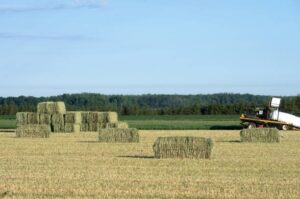Foster has designed and built several bale handling tools for large square bales at his modest shop and machine shed. His most popular design is a front-end bale squeezer for skid steers that gently handles wrapped large square bales.
Research shows that lower moisture hay requires more wrap to limit oxygen movement and prevent spoilage. Buy quality bale wrap for square bales here now.
Wrapping Square Bales
 When appropriately wrapped, square bales prevent moisture from moving inside and spoiling the forage. They also shed water better than unwrapped bales.
When appropriately wrapped, square bales prevent moisture from moving inside and spoiling the forage. They also shed water better than unwrapped bales.
Using plastic wrap is also more cost-effective than other preservatives. However, successful preservation depends on several factors, including the type of forage and the moisture content.
A well-designed and maintained bale wrapping machine ensures high quality and long-lasting forage. The Cross Wrap CW bale wrapper offers easy set-up and operation, with a patented roller angle measuring device and a simple in-cab control unit.
Foster is no Johnny-come-lately, having bought his first square bale wrapper in 1993 — a Kverneland model. He still uses it, but it’s a small part of his business. He now wraps around 10,000 bales a year for farmers throughout southwest Wisconsin. He also wraps silage bales for cattle farmers. These silage bales are often covered in different colours. The colours don’t signify anything; they are usually just what the bailing contractor has on hand at the time.
Bale Wrapping Thickness
Generally, it takes at least six mil of total wrap (six layers of 1 mil plastic or four layers of 1.5 mil plastic) to limit oxygen movement into bales and prevent fermentation. However, oxygen movement is also a function of humidity and the length of storage. Buy quality bale wrap for square bales here now.
Wrapping with net wrap allows hay and straw to hold its shape more effectively than twine and sheds water faster than twine during outdoor storage. This reduces nutrient loss and weather deterioration.
Bales not wrapped properly can experience damage from handling or sloppy stacking, resulting in holes and tears. These can allow moisture or oxygen to enter the bale, causing spoilage or even combustion.
Our CW 2200 Bale Wrapper features an advanced bale conveyance system that gently moves each bale through the wrapping process. This minimizes damage to bales and enables you to achieve high precision. Our machines are ideal for waste-to-energy plants, cement mills and other RDF and SRF processing applications.
Bale Wrapping Time
A quality in-line wrapper can finish wrapping a bale in less than four minutes. In most cases, a few film layers are enough to limit oxygen movement, but crop type, moisture and storage length can impact how many wraps are needed.
In a recent study, researchers found that it is possible to wrap low-moisture baleage after they have been stored for several months without sacrificing forage quality. However, the amount of plastic required increases as moisture levels decrease.
Ideally, a bale is wrapped shortly after it leaves the baler to reduce internal temperature and the start of fermentation. This allows for better storage and preservation of nutrient value.
Bales should be stacked carefully and stored away from trees, where rodents can poke holes in the plastic. Periodically check for damage and repair as necessary to prevent spoilage. Also, keeping bales with the face toward the sun will minimize exposure to ultraviolet rays that degrade plastic films. Buy quality bale wrap for square bales here now.
Bale Wrapping Options
In addition to the cost of film, producers should consider other factors when deciding to wrap bales. For example, wrapping can save on the expense of capping both ends of each tube to prevent spoilage if the bales are tied with sisal twine rather than plastic twine.
It’s also essential to consider how the bales will be handled after they’re wrapped. It’s possible to cause damage to the wrapping, especially on the bottom of the bale stack, by mishandling. This can result in tears, allowing air to reach the forage inside and cause fermentation or spoilage.
Considering these factors, it’s essential to weigh the benefits of tube versus single-bale wrapping for your operation. While tube wrapping offers greater efficiency and preservation, it requires larger equipment and can be more expensive.
